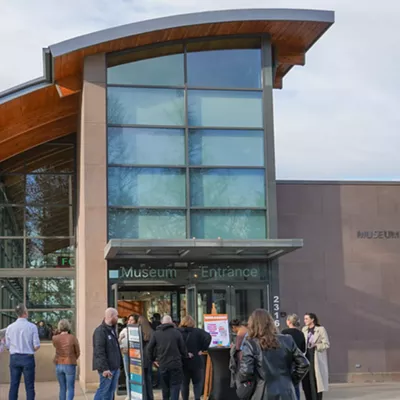Overview #2, for example, is a 4-foot-tall oil painting depicting what appears to be the view out an airplane window. A well-worn wing juts across and nearly bisects the visual space, tense against the light-dappled semi-rural landscape below. The metal gray angle of the wing is repeated in variations of roads that cut across the otherwise green landscape, not only dissecting the land. The verticality of the view is impossible, and it's exaggerated by DeVuono's point-of-view from above the plane. Like the Renaissance masters, DeVuono manipulates perspective and point-of-view not to recreate the illusion of space, but to create the illusion of feeling within space. An "Overview," of course, is exactly what one gets from a plane -- when you're safely above human activity on the ground and removed from it, in the same way that some people live their lives.
DeVuono's exhibit, which celebrates the gallery's 10th anniversary, marks both a return and a departure for the nationally known artist, accomplished writer and professor of art at Eastern Washington University. Asked about what has changed in 10 years, DeVuono explains the influence of her experience at Yaddo (an artists-in-residence program in upstate New York that has hosted writers Truman Capote, Langston Hughes, and Sylvia Plath, as well as artists Milton Avery and Clyfford Still). "Ten years ago," she says, "I decided to do much more representational work, layering text over images." Her decision led to 6-foot-square canvases such as those shown in "Nature & amp; Other Objects," a 2002 show at Yellowstone Art Museum. The images were provocative and ambiguous, painted in the lush, romantic style akin to that of Mark Innerst and possibly even April Gornik. DeVuono's landscapes transcended "mere" representation to subvert humanity's traditional relationship to the land -- that of ownership and dominance. "Waiting" is similarly provocative (though without text), again using landscape as visual metaphor.
DeVuono stepped up her exploration of issues of development and urbanization in an exhibit last December at Gonzaga's Jundt Museum called "American Short Stories," a series of smallish paintings in which images envelop the box-forms on which they're painted. In those pieces, DeVuono continued to push the iconographic potential of the landscape, cropping the image tightly or distorting the text in what was essentially a more overtly narrative direction. Accompanied at the Jundt by a series inspired by the artist's Fulbright-sponsored travels to Kerala, India, DeVuono's depictions of space in "Short Stories" were still relatively grounded in comparison to her most recent works.
In "Waiting," on the other hand, DeVuono makes a sharp departure from the familiar. Her vantage point may be from the ground looking up, as in Histories & amp; Histrionics #11. The sky is improbably chartreuse, nuclear, yet the four planes circling (like hawks?) seem less menacing than they do playful, like swallows diving and effortlessly swirling. In another, the view is looking down at a large, blue-gray plane emerging from clouds that swirl in a lazy vortex, blurred by movement that could as easily be water swirling or a storm gathering.
That sense of movement is one of the most striking features in this series and it carries with it a sense of anticipation that's surreal, mesmerizing. You continue to look into the surface hoping to delineate the deeper meaning.
WaterInert #3 is an example of the mesmerizing, disorienting quality of DeVuono's latest images. Like other works in the series, this has forsaken the familiar horizon line in favor of a dangerously up-close-and-personal view of azure blue water as if viewed from a plane or boat. The safety of the shoreline is gone; we are clearly in the space and in uncharted territory. And yet regardless of any sense of impending impact, we can't tear our eyes away. Looking deeper, is it possible to see a reflection of the plane's wing? Or are we missing something greater in the image?
Although the layering of text from earlier works may be gone, the stratified, codified quality of DeVuono's work isn't. The title of her current series, "Histories & amp; Histrionics," for example, implies a juxtaposition of realities. History changes -- sometimes subtly, sometimes radically -- depending on the point-of-view; histrionics are human dramas. Is it a difference between reality and realism? One can read into things, which is ideal for a Lanny DeVuono painting; there's a lot going on behind the scenes. Regardless, the stage is no longer limited to the ground beneath us. A plane -- once symbolic of freedom, opportunity, adventure -- now carries weightier, more complex symbolism. And from DeVuono's vantage point, the landscape offers a continuing narrative of infinite possibility.
Lanny DeVuono exhibits "Waiting" from Nov. 3-25 at the Lorinda Knight Gallery, 523 W. Sprague. Gallery hours: Tuesdays-Saturdays from 11 am-6 pm. Artist reception: Friday, Nov. 3, from 6-8 pm. Poetry and photographs by Ruth Beal will also be on display. Visit www.lorindaknight.com or call 838-3740.
















